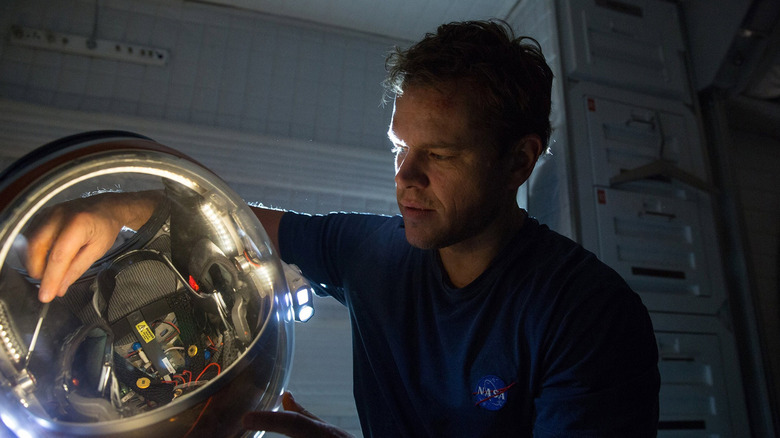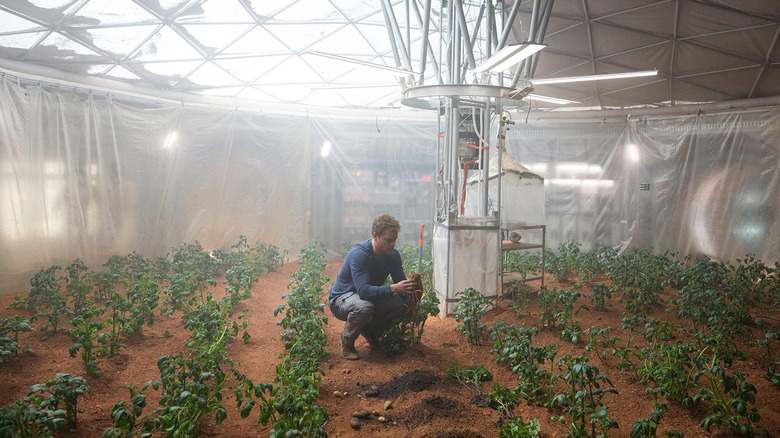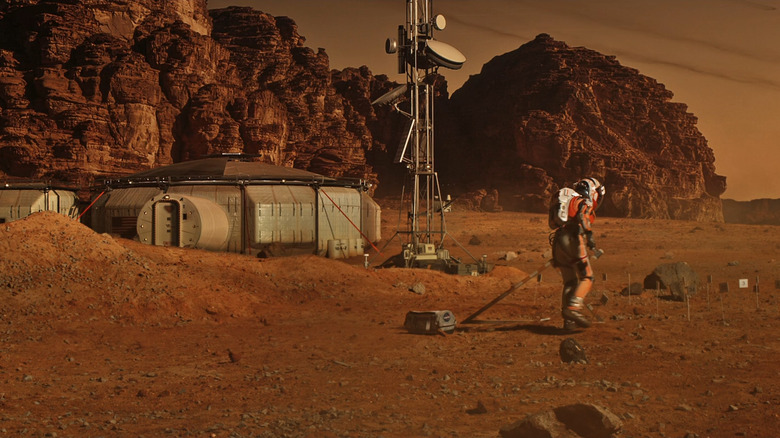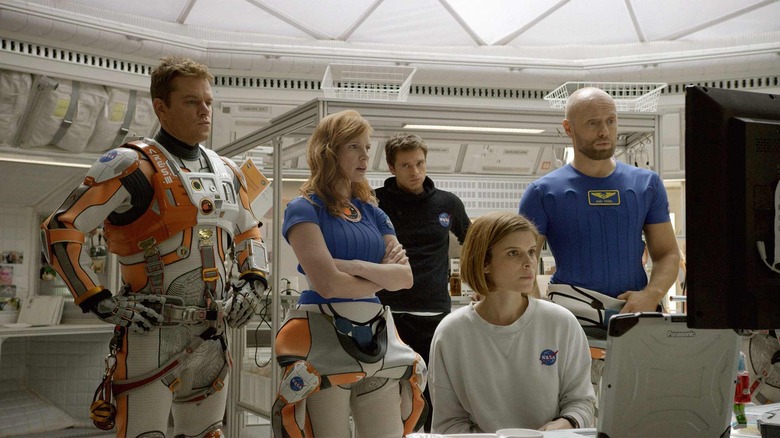The Technology In The Martian Is Being Created In Real Life
"In the face of overwhelming odds, I'm left with only one option: I'm going to have to science the s*** out of this."
So spoke Mark Watney (Matt Damon), the title character in Ridley Scott's 2015 film "The Martian," easily one of the best films of its year. Written by Drew Goddard after the novel by Andy Weir, the film had a pretty simple thesis: Science, knowledge, and engineering know-how were not just superpowers, but could be the stuff of ripping entertainment. Most importantly, "The Martian" reveals that our most human quality — our good humor — will be our most vital survival tool. The film is gloriously propulsive and infectiously funny, despite being a desperate story of a man stranded on the surface of Mars.
Watney, the mission's botanist, is left behind after a sandstorm forces his astronaut companions to leave, and he has to find ways to extend his air and water supply in his temporary habitat, grow food in the Martian dirt (he grows potatoes using the crew's own manure), and move about the planet's surface salvaging what supplies he can from other Martian missions (the film takes place in the near future, when such missions are common). It helps to have music, though woe to Watney for only having a playlist of 1970s disco hits to keep him company.
If you're wondering how he eats and breathes and other science facts, then know NASA has that well in hand. Much of "The Martian" was based on real tech currently used or in development for actual space travel.
HERA
A trip to Mars would take many months, and any astronauts traveling there would have to learn to survive in an enclosed habitat — referred to as the Hab in "The Martian." NASA's current experimental habitat for potential use on the Martian surface is called the HERA (Human Exploration Research Analogue). Compared to the Hab in the movie, the HERA facility is an enormous hotel, featuring two floors(!), living quarters, a shower (it's called a hygiene module), and a greenhouse for growing food.
While living on the module for weeks at a time, astronauts in training are not allowed outside (natch), and they have to complete the same mission tasks they would while on another planet. The HERA habitat has already been used for research related to the International Space Station, and it's useful not just for practical reasons (supply levels, ergonomics, etc.), but for behavioral ones as well. The psychology of being bound inside a small module on a distant planet for an extended period may take a toll on mental health, and living in the facility would gauge that. One would hope the astronauts would be given more music than a mere disco playlist.
Food and water
A mission to Mars could only bring so much food. Every pound on a space shuttle needs to be calculated and paid for, and the lighter one can make their mission, the better. Given that a Mars trip would take months, food would need to be produced on the planet's surface out of necessity. This means gardening (and no, NASA is not sending livestock to Mars). As mentioned above, Watney's food supply in "The Martian" was constructed with reclaimed water, potato seeds, and human waste. Not a great diet, but doable for the desperate situation.
The ISS currently has a system in place called Veggie, a system where small plants are grown inside miniature "pillows" full of dirt and fertilizer and that produces edible plants on a limited basis. Veggie proved successful in 2014, though citizens on the ISS still rely on deliveries from Earth for most of their provisions. This isn't yet enough to feed a cadre of astronauts, but it's a darn promising start.
Water is a trickier problem, as liquids behave much differently in low gravity than they do on Earth, and transporting a lot of them to Mars would be difficult and heavy. Culling drinkable water from the planet is also a bugaboo, as NASA missions have revealed only small deposits of ice and trace water vapor in the Martian atmosphere, and it's hard to tell how useful it might be to an astronaut. The ice at the Martian poles is mixed with frozen CO2, making it unpalatable. Recycling human waste seems like the obvious answer, and NASA is working on complex filtration to make that happen.
Air and breathing in a spacesuit
Air is easier to produce than you might think, and the ISS already has a pretty efficient system in place for generating breathable air called the Oxygen Generation System. Using electrolysis, the ISS can split water molecules into their base atoms (hydrogen and oxygen), releasing the breathable particles into the atmosphere, and shooting the hydrogen out into space. Some of the hydrogen is salvaged by something called the Sabatier system, which can fuse the carbon dioxide molecules breathed out by the astronauts with the rogue hydrogen produced by electrolysis and make water.
The most prominent feature seen in "The Martian" is Watney's spacesuit, and NASA scientists have been working for years to find just the right balance of cloth and hard elements to balance protection with durability and comfort. NASA knows there is not going to be one universal spacesuit that will function for every job, so several versions would be needed. The current prototype of Martian spacesuit is called the Z-2, and it looks like something from a 1950s sci-fi movie. Which is cool. Next on the design docket is a spacesuit that can be left outside to avoid tracking Martian dust into the habitat.
Ion propulsion
In "The Martian," the central ship, the Ares 3, talks a lot about getting to Mars on ion propulsion. "Ion propulsion" may sound like a "Star Trek" conceit, but it is, in fact, a real way a ship can travel. Ions, as we all remember from fourth grade science class, are electrically charged particles, and in an ion propulsion engine, molecules of argon or xenon are charged, with the charged elements squeezed out the back boosters as enormous speeds. According to NASA, close to 200,000 mph. That sounds like a lot, but it's actually a very gentle push. Like "a gentle breeze," in NASA's words.
However, given that the trip to Mars is 140 million miles, and acceleration can only increase over the course of the journey, such a breeze is all that would be needed to eventually get a spacecraft up to enormously fast speeds. What's more, a gentle "push" from an ion engine would be an ideal way to steer a craft without expending a lot of energy. The spacecraft Dawn used ion propulsion continuously for years to eventually orbit dwarf planet Ceres, located between Mars and Jupiter.
While "The Martian" is not science fact, it's a kind of hard science fiction that is exhilarating to watch, and give viewers hope that humanity — with its know-how and ability to smirk — will persist in a positive direction.




